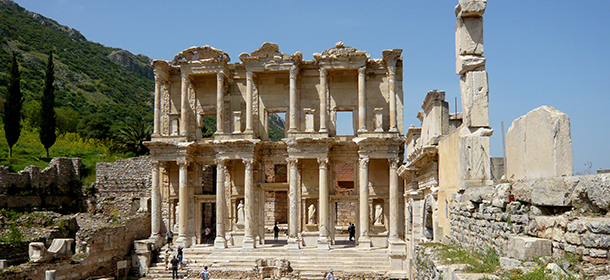Full Day Ephesus Tour
Meet at the lobby of your hotel in Izmir or at the airport. Begin the tour of visiting Ephesus, famous for its Temple of Artemis, one of the Seven Wonders of the world, where St. Paul preached (Acts 18:19-28; 19:1-41). And the world famous Celsius Library, Roman theater holding 25.000 spectators, the Odeon, the temples of Hadrian, and Roman private houses; the House of Virgin Mary, the Basilica of St. John and Sirince Village The tour will terminate in Izmir airport or hotel.(L)
Main Sites:
Ephesus that we visit today is one of the greatest ruined cities in the western world which was founded in 300 BC by Alexander Great’s successor, Lysimachus. But it was under the Romans that Ephesus became international chief port on the Aegean and the world trade center. Most of the surviving structures date from this period. As the harbor silted up the city declined, but played important role in the spread of Christianity. Two great Councils of the early church were held here in AD 431 and 449. It is said that the Virgin Mary her last years nearby and St John the Evangelist came here and look after her.
The site is large. In fact, Ephesus contains the largest collection of Roman ruins in the east of the Mediterranean. Only an estimated 15% has been excavated. The ruins that are visible give some idea of the city`s original splendor, and the Street which leads down to the long silted-up harbor.
The Library of Celsius, whose façade has been carefully reconstructed from all original pieces, was built ca. AD 125 by Gaius Julius Aquila in memory of his father, once held nearly 12.000 scrolls. Designed with an exaggerated entrance – so as to enhance its perceived size, speculate many historians – the building faces east so that the reading rooms could make best use of the morning light.
A part of the site, St. John`s Basilica, was built in the 6th century AD, under emperor Justinian I over the supposed site of the apostle`s tomb. It is now surrounded by Seljuk.
The Temple of Artemis, one of the Seven Wonders of the Ancient World, is represented only by one inconspicuous column, revealed during an archaeological excavation by the British Museum in the 1870s. Some fragments of the frieze (which are insufficient to suggest the form of the original) and other small finds were removed – some to London and some to the Archaeological Museum, Istanbul. Other edifices excavated include:
- The Odeon – a small roofed theatre constructed by Vedius Antonius and his wife in around 150 A.D. It was a small salon/hall for plays, concerts, small acts and official meetings seating about 1.500 people. There were 22 stars in the theater. The upper part of the theatre was decorated with red granite pillars in the Carinthia style. The entrances were at both sides of the stage and reached by a few steps.
- The Temple of Hadrian dates from the 2nd century but underwent repairs in the 4th century and has been re-erected from the surviving architectural fragment. The reliefs in the upper sections are casts; the original ones are being now exhibited in the Seljuk Archaeological Museum. A number of figures are depicted in the reliefs, including the emperor Theodosius I with his wife and eldest son.
- The Temple of Domitian was one of the largest temples on the city. It was erected on a pseudo dipteral plan with 8 x 13 columns. The temple and its statue are some of the few remains connected with Domitian.
- The Theater – At an estimated 25.000 seating capacity, it is believed to be the largest outdoor theater in the ancient world.
- The Tomb | Fountain of Pollio – erected by a grateful city in 97 AD in honor of C. Sextilius Pollio, who constructed the Marnas aqueduct by Offilius Proculus. It has a concave facade.
- The two double Agoras an (State and Public Agoras) that both were the center of trade in the ancient world, the center of ancient.
- The Terrace or Private houses were built on the hillside were the residence of rich/wealthy Ephesians


